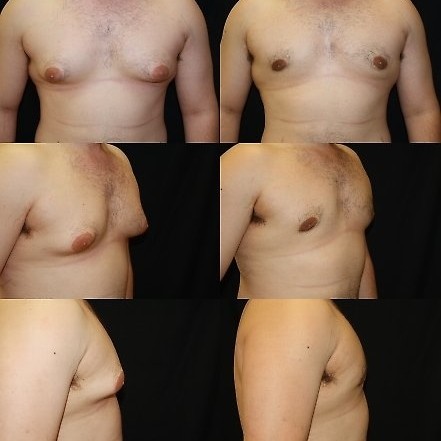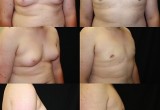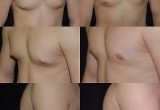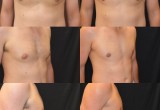Male Breast Reduction
Male Breast Reduction helps treat Gynecomastia, a condition of over-developed or enlarged breasts in men, is common in men of any age. It can be the result of hormonal changes, heredity conditions, disease or the use of certain drugs. Gynecomastia can cause emotional discomfort and impair your self-confidence. Some men may even avoid certain physical activities and intimacy simply to hide their condition. Gynecomastia is characterized by: Excess localized fat, Excess glandular tissue development, A combination of both excess fat and glandular tissue.
THE BEST CANDIDATES FOR MALE BREAST REDUCTION
This procedure is a good option for you if you are physically healthy and of relatively normal weight, have realistic expectations, your breast development has stabilized, and you are bothered by the feeling that your breasts are too large. Adolescents may benefit from surgery, although secondary procedures may be needed in the future should breast development continue. You mustn’t smoker or participate in illegal drug use. Be prepared to discuss your expectations and desired outcome, medical conditions, drug allergies, medical treatments, use of current medications, vitamins, herbal supplements, alcohol, tobacco and drugs including steroids.
ALL SURGERY CARRIES SOME UNCERTAINTY AND RISK
A male breast reduction is normally safe when performed by a board-certified plastic surgeon. Nevertheless, as with any surgery, there is always a possibility of complications or a reaction to anesthesia. Bleeding and infection following a male breast reduction are uncommon, but they can cause scars to widen. You may reduce your risks by closely following Dr. Baroody's advice both before and after surgery. The procedure can also leave you with unevenly positioned nipples, or a permanent loss of feeling in your nipples or breasts. Rarely, the nipple and areola may lose their blood supply and the tissue will become non-viable. (The nipple and areola can usually be rebuilt).
PLANNING FOR YOUR MALE BREAST REDUCTION
In your initial consultation, it is important to discuss your expectations frankly with Dr. Baroody. Dr. Baroody will describe the procedure in detail, explaining its risks and limitations and making sure you understand the scarring that will result. Do not hesitate to ask Dr. Baroody any questions you may have, especially those regarding your expectations and concerns about the results.
PREPARING FOR YOUR SURGERY
You will also receive specific instructions on how to prepare for your male breast reduction, including guidelines on eating, drinking, smoking, and avoiding certain vitamins/medications. While you are making preparations, be sure to arrange for someone to drive you home after your surgery and to help you out for a few days if needed.
WHERE YOUR SURGERY WILL BE PERFORMED
Dr. Baroody performs the procedure at New Milford Hospital and Orthopaedic and Specialty Surgery Center.
TYPES OF ANESTHESIA
Male breast reductions are performed under general anesthesia, which means you will be asleep throughout the operation.
THE SURGERY
In cases where gynecomastia is primarily the result of excess fatty tissue, liposuction techniques alone may be used. This requires insertion of a cannula, a thin hollow tube, through several small incisions. The cannula is moved back and forth in a controlled motion to loosen the excess fat, which is then removed from the body by vacuum suction. Excision techniques are recommended where glandular breast tissue or excess skin must be removed to correct gynecomastia. Excision also is necessary if the areola will be reduced, or the nipple repositioned to a more natural male contour. Incision patterns vary depending on the specific conditions and surgical preference. The most common scar placement is a very inconspicuous scar along the lower edge of the areola. Often times gynecomastia is treated with both liposuction and excision.
AFTER YOUR SURGERY
You will wear an elastic bandage over gauze dressings after surgery. Your chest will be bruised, swollen, and uncomfortable for a day or two, but the pain should not be severe. Any discomfort you feel can be relieved with prescribed medications. Within a couple days, the bandages will be replaced by a compression vest. You will need to wear this garment around the clock for two to three weeks. If your chest skin is very dry following surgery, you may apply a moisturizer several times a day. Be careful not to tug at your skin in the process, and keep the moisturizer away from the suture areas. Expect some loss of feeling in your nipples and chest skin, caused by the swelling after surgery. This numbness usually fades as the swelling subsides over the next six weeks. In some patients, however, it may last a year or more, and occasionally it may be permanent.
GETTING BACK TO NORMAL
After Male Breast Reduction...
For Gynecomastia (Male Breast Reduction), healing is a gradual process. Although you may be up and about in a day or two, do not plan on returning to work for a week or more, depending on how you feel. Avoid lifting heavy objects for three to four weeks. If you have any unusual symptoms, do not hesitate to call Dr. Baroody. Dr. Baroody will give you detailed instructions for resuming your normal activities. You may be instructed to avoid strenuous sports for about a month. After that, you may resume these activities slowly.













